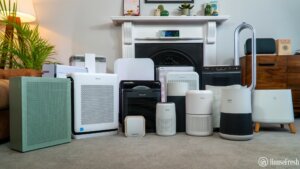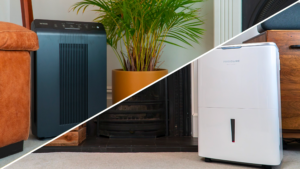We’re not fans of scaremongering here at Housefresh. Our mission is not to scare you into purchasing something that isn’t going to help you. Nor are we scientists who can claim to know the ins and out of every aspect of air quality.
We are just humble consumers with a fascination for science. Our mission is to do our research and present you with the facts, so you can decide for yourself. We’ve been researching air quality and testing air purifiers for years though, so we’re not shy at claiming to be experts.
I read as much as I could find about dust mites before writing this article, and here’s what I found out. Long-term exposure to dust mites in your home can really impact your health, and they can be especially troublesome for people with asthma and those who are allergic or sensitive to them. People with asthma who are sensitive to dust mites even face an increased risk of asthma attacks.
A mild reaction may result in a runny nose, watery eyes, and sneezing. But in more severe cases, the condition can cause persistent sneezing, cough, congestion, facial pressure, or even a severe asthma attack.
But what are dust mites, and can we see them? Read on to find out.
What is a dust mite?
A dust mite is an insect-like pest. They are not parasites that can bite, sting, or burrow into our bodies (thank goodness). But they do produce feces and urine before eventually dying, and we can inhale all of it, including their tiny dead bodies.
They feed on dead human skin cells (tasty) and they thrive in warm, humid settings.
On an average day, one person might shed 1.5 grams of dead skin cells, and all of that delicious skin can feed up to one million dust mites at a time.
The size of dust mites
Our researchers collaborated with incredibly talented multimedia illustrator, Hanif Rashid to create this graphic which shows the relative sizes of the most common indoor air pollutants. That’s the eye of a needle by the way, in case you missed it.
As you can see, dust mites are small. Very small.

The microscopic arthropods are estimated to be 1/4 to 1/3 millimeters long. For context, a single one of those tiny bugs is as big as a single grain of table salt. You can only see them under a microscope, and even then, they only look like small white spider-like creatures. Because of their translucent coloring, dust mites can be difficult to notice, even through a microscope.
What do dust mites look like?
Thanks to Hanif’s 3D renders, we can get a close look at this bad boy. As you can see, dust mites look a bit like ticks, with eight bristly legs, no visible eyes, and a sturdy glass-like shell.

In short, they look like aliens. They’re not green in real life though, they’re creamy white, pretty much translucent. Even so, they wouldn’t look out of place in a Men in Black Movie, if they were big enough to see that is.
Where do dust mites come from?
Dust mites can live quite cozily in your bedding, mattresses, upholstered furniture, carpets, or curtains. Male dust mites can live over a month, while female dust mites can live up to 90 days.
Roughly four out of five homes in the United States have dust mite allergens in at least one bed, and mattress may house anywhere from 100,000 to 2 million mites, according to research.
Here are the 4 perfect living conditions for dust mites:
- Warm temperature of around 21 – 25°C
- Dark places where direct sunlight rarely comes in
- 50% to 70% air humidity
- Nearby humans or animals (to eat)
Humidity is the most important factor for dust mites when they’re deciding where to live. They do not drink water, instead they absorb moisture from the air so humidity is key when they’re house hunting. They cannot survive in areas with low humidity, like deserts.
Do you have dust mites in your home?
The most common signs of dust mites are allergic reactions. If you inhale or touch them, the proteins in their feces may force your system to produce antibodies to defend itself.
Here are some of the most common symptoms of a dust mite allergy:
- Fever
- Watery and itchy eyes
- Runny nose
- Continuous sneezing
- Asthma episodes
- Red and itchy skin
- Nasal blockage
- Irritated mouth or throat
4 ways of preventing dust mites
Luckily, there are some tips and tricks that you can do to keep the dust mites away.
We’ve looked to the experts and curated this list of what, we think, are the most effective and quick strategies to undertake.
1. Reduce humidity
Keep your home below 50 percent humidity. In very humid areas, dehumidifiers can help.
Ventilate your rooms daily for at least 10 to 20 minutes.
2. Reduce the places where dust mites can live
- Replace upholstered furniture with items that have smooth surfaces
- Onlt have drapes and curtains where absolutely nessesary
- Cover mattresses and pillows with allergen encasements
- Wash bedding in very hot water (at least 120 degrees F) once a week
- Reduce clutter
3. Replace carpets
We highly recommend that carpets are removed, especially if occupants are allergic to dust mites. If you must have carpets, use a good vacuum cleaner with a HEPA filter.
Damp clean floors often, focusing on catching dirt and dust without wet mopping.
4. Dust regularly
When dusting, use something that can trap and lock dust like a wet washcloth or a microfiber cloth to reduce the amount of dust that is stirred up when cleaning.
That’s our strong four, if you do them regularly you’ll be well on your way to reducing dust. But for more surefire tips, check out our detailed report on eliminating dust.
The best air purifiers For dust mites
Air purifiers are one of the most effective tools for removing those pesky dust particles from your home. The units we have recommended below all utilize HEPA filters. These filters are certified to capture 99.7% of airborne particles as small as 0.3 microns. So removing dust from your space is light work for a HEPA-powered purifier.
Final thoughts
Dust mites might be invisible to the naked human eye, but they are lurking throughout your home and can be difficult to deal with if you have a dust allergy. Armed with this new information, including where they like to live and in what conditions, you can do your best to keep them at bay and avoid suffering the consequences.
SOURCES
- Mayo Clinic. (2022). Dust mite allergy – Symptoms and causes. mayoclinic.com
- National Institute of Environmental Health. (2022). Dust Mites and Cockroaches. nih.gov
- American College of Allergy, Asthma and Immunology. (2022). Dust Allergy | Causes, Symptoms & Treatment. acaai.org
- Schei, M.A, Hessen, J.O, Lund, E. (2022).House-dust mites and mattresses. nih.gov
- Ashton, D. (2022). The Most Humid Cities In The World. housefresh.com
- Yacoubou, J. (2022). Do Dehumidifiers Clean The Air? housefresh.com
- Cookson, M (2022). How To Reduce Dust In Your Apartment. housefresh.com
Last update on 2024-04-18 / Affiliate links / Images from Amazon Product Advertising API






